Key in a search term below to search our website.
Key in a search term below to search our website.
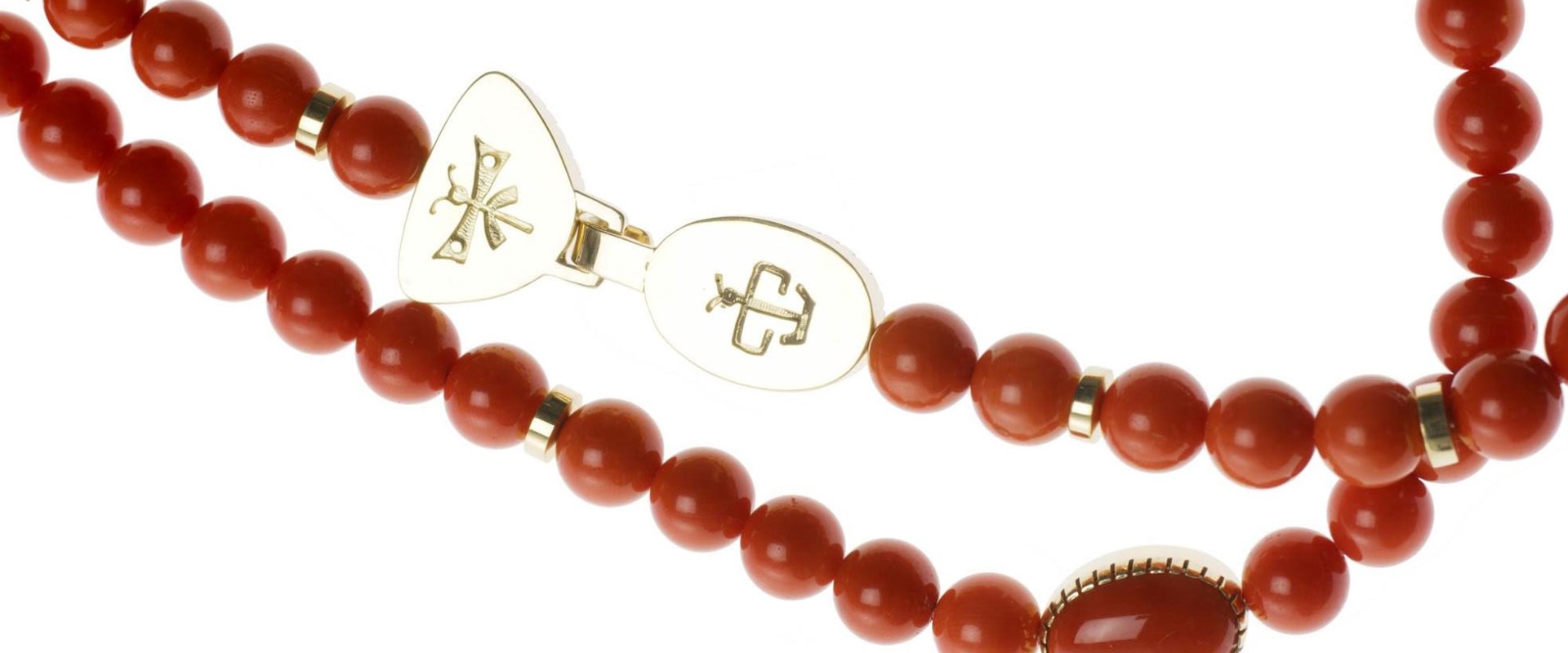
This opulent deep red coral and 18 carat gold necklace was created by Yazzie Johnson and Gail Bird. The self-taught artists are seen as key innovators and established figures in the field of contemporary Southwestern American Indian jewellery, taking their inspiration from traditional Native American design and the precious materials they use in their pieces.
Date
2009
Made in
New Mexico, USA
Made by
Yazzie Johnson (b. 1946) and Gail Bird (b.1949)
Made from
Coral, gold
Dimensions
Length 930mm
Acquired
Purchased from Yazzie Johnson and Gail Bird
Museum reference
On display
Inspired by Nature, Level 5, National Museum of Scotland
Did you know?
Johnson and Bird have known each other since childhood and started making jewellery together in 1972.
“This necklace is... a fashion piece, a very wearable object, but has also a very traditional cultural link because of the colours and the material.- Gail Bird, 2009
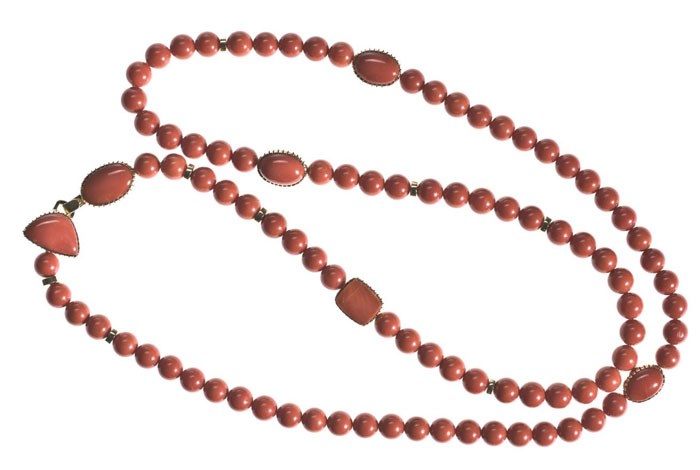
With this necklace, Bird and Johnson have created a unique work which reflects both their indigenous cultures and their passion for contemporary design. Working in New Mexico, the pair display their jewellery at the Santa Fe Indian Market, the largest Native American Indian arts market in the world, where the necklace was acquired in 2009.
The necklace consists of coral beads, six bezel set cabochon coral pieces, and eight hand-forged gold spacers.
Speaking at a conference in London in 2009, Bird explained that the pair considered their work ‘an extension and continuation of the jewellery arts of the Southwest.’ In this necklace, the size and shape of the eight discoidal gold beads resemble shell and stone necklaces produced in the Southwest for centuries, while the six coral cabochon are reminiscent of to the large beads commonly associated with early Navajo and Pueblo jewellery.
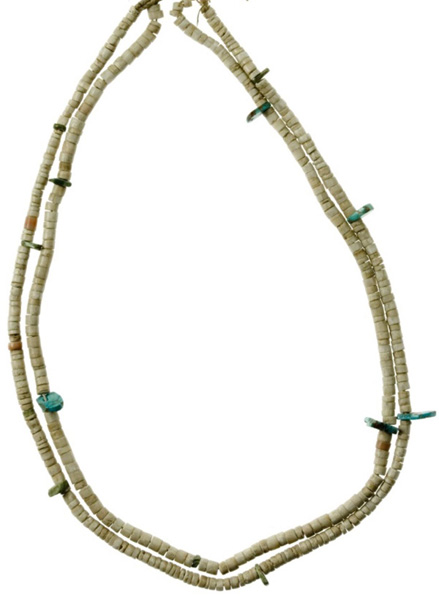
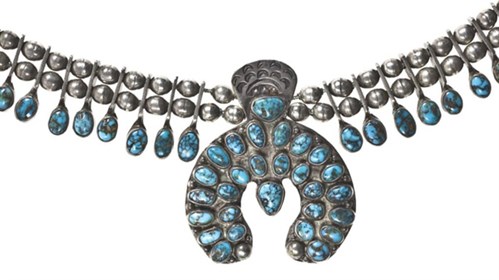
Above: The Pueblo shell necklace (top) and Navajo silver & turquoise squash blossom necklace (below) both display traditional Native American jewellery design techniques which inspired aspects of the necklace.
The choice to use only the rarest and highest quality coral available also visually relates the necklace to traditional Native American jewellery design, as well as adds to its uniqueness, as Bird explained during a visit to National Museums Scotland in December 2009:
“Coral in the Southwest is seen as a precious resource. It really has become part of the value system, and the culture of both Pueblo and Navajo people. It’s incorporated into the colour scheme and the belief system of the Navajo and into the traditional apparel of Pueblo women.
Collaborating since the early 1970s, Bird and Johnson have developed a distinctive aesthetic. Each piece is hand-made, combining the artists’ keen sense of contemporary design with unique materials and traditional techniques, perfected through years of self-study and experimentation. Currently working mainly in gold with a wide range of precious stones, the pair select the materials for each piece carefully. A particular stone is only used when they believe they have found the right design in which to display it at its best.
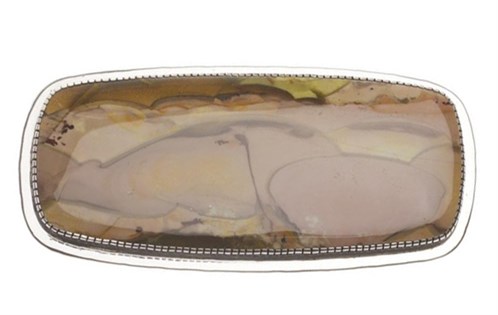
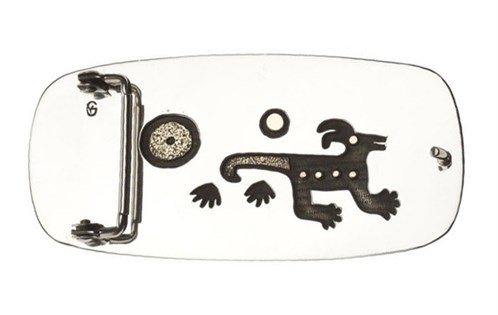
Above: Front (top) and back (below) details of the silver and imperial jasper belt buckle by Johnson and Bird, 2009.
A distinguishing feature of their work are the necklace clasps, which typically are treated as an integral part of the overall piece. This necklace is intended to be worn with the decorative clasp on the right side of the wearer’s neck, creating an asymmetrical design.
An expert silversmith, Johnson’s accomplished metalwork skills can be seen in the ‘underlay’ technique incorporated in the underside of their stone settings. In this necklace they feature dragonflies and butterflies inspired by traditional pottery designs and petroglyph (rock painting) images. The coral cabochon pieces swivel, allowing the wearer to alternate between displaying the coral stone and the gold underlay.
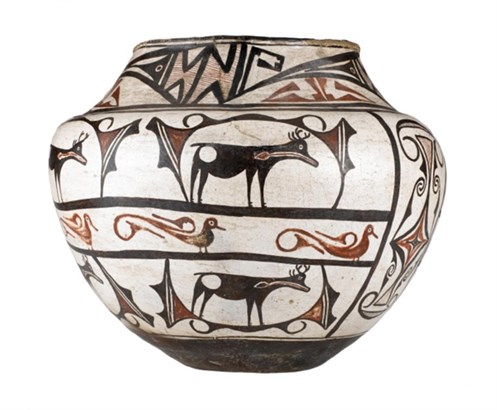
Above: Oblate water vase, or olla, painted in black and red with figures of an elk and roadrunner: Zuni Pueblo, New Mexico, USA, c. 1900.